A Guide To Tackling Mt. Kilimanjaro via the Lemosho Route
You’ve either decided to take action, throw caution to the wind and are ready to climb Mount Kilimanjaro or you’re cautiously researching before you book your excursion.
Either way, Hakuna Matata!
What is Mount Kilimanjaro?
Not only is Kilimanjaro the highest mountain in Africa, a dormant volcano, the tallest freestanding mountain in the world but it is also one of the famous 7 peaks with 19,321 ft above sea level.
Uhuru Peak is the highest summit on Kibo’s crater rim (one of three distinct cone craters on the mountain) Nicknamed “The Every Mans Everest” it is a popular bucket list item for any adventure or endurance seeker.
While initially, taking on the mountain might seem like a task for the Pros, it is easily tackled with some planning. While this article is by no means the be-all-end-all reference, we wanted to give a bird’s eye view to get started and a few do’s and don’ts we have noticed through the team’s experience.
Packing List Musts:
In addition to the basic list, there are some must-haves that didn’t make the basic needs list but made all the difference.
- LuminAID PackLite Max Phone Charger Lantern
- Dr. Bonner’s Organic Liquid Soap (in addition to at least 50 baby wipes, this is helpful for added washing)
- North Face Base Camp Duffle XL (They recommended large but more room would have been fantastic)
- Black Diamond Oval Carabiners(These came in handy for all sorts of things)
- North Face Short/Pant Hiking Pants (This is four in two! Saves space and money!)
- Basic Packing/Buying Guide: Embark Packing List
Training:
Inside Endurance Nation, we created a basic 13-week training schedule to prepare for Kilimanjaro on the heels of our Run Durability program. The plan includes hiking training, strength & core functionality, basic run durability, and recommendations for stretching and yoga sessions.
Do’s
- Focus on strength and core training
- Stretch! Either yoga or stretching for runners is a must
- Break in your shoes and test out all your gear
- Get your daypack fitted specifically for you and learn how to adjust it and wear it on every practice climb
- Practice eating the same snacks/protein-power bars that you will eat on the climb
- If possible, spend some time at higher altitudes and even better if you can do so for training
Don’ts:
- Only focus on cardiovascular strength – basic fitness is important but you are told to go “pole pole” which means very slow in Swahili – the purpose of this is to acclimate to the altitude as you trek. At no time are you suppose to be in any kind of major zone heart rate, breaking a major sweat or out of breath.
- Have only one discipline of sports focus. Training for success should have a plan outline that includes multiple sports (running, walking, strength, yoga, even swimming) that can get you ready from a physical standpoint.
Snacks to Pack:
While the trekking company provides you with three meals a day and usually a small snack right when you get to camp – it is best to pack snacks for the trek between meals. You need to be eating constantly.
Carbs? Yes! Protein? Yes! Sugar? Yes! You will burn it.
- Gu Waffles
- Clif Bar Protein Bars
- Snickers (trust me you will want some kind of candy bar treat)
- Salty Almonds (you need the sodium – single packets work great)
- Nabs (cracker packets)
- Gels, Clif Blocks, Energy Beans etc
- Gummy Bears (ok not mandatory but this is a treat for me and I saved it for the day before summit as a carrot reward for myself and I was so happy I did)
- Nuun hydration tabs/Gatorade powder
Plan on packing at least two/three of the above in combination for every day. Again, gear organization is key here. Place every day’s snacks in their own ziplock bag, labeled. This makes it easy to take out of your large duffle and throw in your day pack every morning and keep you accountable for eating it.
The first day of the trek my stomach hurt and I grabbed a can of Pringles at the gas station before we started the four-hour drive to the gate… I really enjoyed having them for when I needed some salt or when my “travel tummy” was upset with me.
(see the famous Pringles can?!)
What Company To Use & Why:
Embark Exploration Co is the company we recommend for Kilimanjaro, Everest Base Camp, and all of your other epic adventures.
Honest, knowledgea
From Day One we were blown away by the level of service and attention to detail. Every moment from inquiry to prep – from the start of the trip to the memories that will last me a lifetime, we are confident you will feel amazed by the Embark brand.
Their porters, guides, and staff go above and beyond the call of duty. They don’t simply believe this is a job, they know they are altering the course of your life and they seem to relish in making sure you feel safe, happy and cared for. Since these traits mirror what Endurance Nation is all about, it is a perfect fit to trust them with our epic explorations.
Porter Care:
Established in 2003, the Kilimanjaro Porters Assistance Project (KPAP) is a legally registered Tanzanian not-for-profit organization. Their Mission is to improve the working conditions of the porters on Kilimanjaro. KPAP is not a porter membership organization, or a tour operating the business, and they do not collect any fees from porters or climbing companies. KPAP is an initiative of the International Mountain Explorers Connection (IMEC), a 501(c)3 nonprofit organization based out of Boulder, Colorado in the United States.
Those who have climbed Mount Kilimanjaro know that porters are the backbone of the trek. Many climbers may not realize that porters can be ill-equipped, poorly paid and have improper working conditions. KPAP’s focus is improving the working conditions of the porters by:
- Lending mountain clothing to porters free of charge
- Advocating for fair wages and ethical treatment by all companies climbing Kilimanjaro
- Encouraging climbers to select a climbing company with responsible treatment practices towards their crew
- Providing educational opportunities to the mountain crew
Please make sure whoever you choose to trek with is on the list of participating companies located on the KPAP website.
Also, consider a donation to this amazing organization. Without the porters, the trek is simply not possible.
Mental Side of Training:
Before the trip, we recorded a podcast with a sports psychologist entitled- The Psychology of Endurance Mental Toughness
The knowledge learned on that podcast proved to be highly valuable in ways that never could have been expected.
Key Take-a-Ways
- The moment you want to quit, remember, you’ve only accomplished about 40% of what your body can actually handle. Reminding yourself of this can be a bit of a mantra as you continue to trek forward.
- Get comfortable with the uncomfortable – There isn’t much of the Kilimanjaro journey that is comfortable by everyday standards. You are either hot in the rainforest, cold in the arctic desert, sore from activity, sore from sleeping on the ground, wet from the rain, wet from the snow, headaches from altitude sickness, upset tummy from nerves/travel, homesick, excited, fear, anxious, smelly from no showers, in need of alone time from being constantly around campers, frustrated from the terrain, sleepy etc. You name it, you will experience it.
- Even with all the uncomfortable, you will feel intense highs of gratitude, excitement, and joy.
- Find an accountability partner on your trek. Whether its a friend you have made the journey with or even your guide. Let them know your limits, your wishes, your goals and ask them to remind you of those goals if you start to fade or express interest in quitting. Sometimes, all we need is someone in our corner saying “you want this, you can do this”
- Find your “why” and repeat it to yourself over and over again. Why are you doing this? Have that mental conversation ready so when your body/brain wants to throw in the towel you can tell it, NO! I’ve only done 40% and there is a reason for this… we continue on!
- Keep a journal, both written and video. You can go back and watch/read and see how far you have come and gained energy every day.
- Have a friend/family member/loved one write you a note to read at the summit… and tell yourself that you don’t get to read the note until you reach the summit. This can be a fantastic mental carrot.
It Pays To Be Organized:
- Ziplock bags, duct tape & a sharpie. Put all of your clothes by genre in their own gallon ziplock bag, a label on a bright strip of duct tape. This will hold the moisture out of the clothes, make packing easier and repack every day very quickly.
- Pack extra Ziplock bags and a couple trash bags for dirty clothes
- Add a dryer sheet to each ziplock bag (your nose will thank you mid/end of the trip)
- Get travel insurance (including medical)
- Put together your travel information and emergency details in a Google spreadsheet to share with family
- Print your itinerary just in case
- Take pictures of your passport, license, and Global Entry information just in case
- Grab a Global Entry & TSA PreCheck Prior to the trip
- Separate your tipping allocation from your spending allocation
- Wear a RoadID on your body and have your bag tags fully filled out
Route Logistics:
- 72k Total
- 8 Days
- 5 Ecosystems
Review the data files, Google Interactive Map and more at fellow trekkers, Derick Black’s blog There will also be amazing images he captured on this page as well, be sure to check out his amazing talent!
Day One: Londorossi Gate to Mti Mkubwa
- Elevation (ft): 7,800ft to 9,500ft
- Distance: 6 km
- Hiking Time: 3-4 hours
- Habitat: Rain Forest
Tip: Sunscreen, Sunhat & Bugspray. Make sure you are taking your Malaria medicine. Lots of monkeys at this part, make sure to have your camera ready!
Day Two: Mti Mkubwa to Shira Camp 1
- Elevation (ft): 9,000ft to 11,500ft •Distance: 8 km
- Hiking Time 5-7 hours
- Habitat: Moorland
Tip: Make sure you are eating all your snacks, this is not a time to try and lose weight, you need your energy! You exit the rainforest on this hike and enter the Low Alpine Zone – beautiful scenery!
Day Three: Shira Camp 1 to Moir Hut
- Elevation (ft): 11,500ft to 13,800 ft
- Distance: 14 km
- Hiking Time: 5-6 hours
- Habitat: Moorland
Tip: The easiest hike of the trip because most of the land is flat, this is the Shira Plateau (one of the highest on earth) take it all in, it is beautiful. Very dusty so make sure to blow your nose and use saline if you have it. Stop taking your Malaria medicine as no mosquitos exist outside of this area and it can make altitude sickness greater. Resume the medicine at decent!
Day Four: Moir Hut to Lava Tower to Barranco Camp
- Elevation (ft): 13,800ft to 15,100ft
- Distance: 7 km
- Hiking Time: 6-9 hours
- Habitat: Semi-Desert
Tip: Where things get real! Not a strenuous climb, but mentally taxing. If the weather isn’t cooperating you will have to dig deep into that mental toughness reserve. Leaving Lava Tower is extremely steep downwards. Watch your footing! However, beautiful views of the mountain all day. Be prepared to be in awe. Before you reach camp, lots of streams and waterfalls. The scenery is something out of a Dr. Seuss book!
Day Five: Barranco Camp to Karanga Camp
- Elevation (ft): 13,000ft to 13,100ft
- Distance: 5km
- Hiking Time: 6-9 hours
- Habitat: Alpine Desert
Tip: Barranco Wall Day! Approach this with caution but excitement. Use your guides and fellow trekkers outstretched hands for leverage. Make focus your main goal but do not forget to soak it all in, next to the summit, this is the coolest part of the trip. Make sure to plant a big fat kiss on the kissing rock! When you reach the top… EAT! You have another 4-5 hours left in the day and it will seem to drag on forever. Lots of clothing layers here as you will teeter between hot and cold no matter the weather circumstances.
Day Six: Karanga Camp to Barafu Camp
- Elevation (ft): 13,100ft to 15,300ft
- Distance: 4 km
- Hiking Time: 4-5 hours
- Habitat: Alpine Desert
Tip: You will sleep beneath the mountain base and be in complete awe of what you are about to accomplish. During this day – you need to eat, eat, eat! Make sure not to have any caffeine as you will have an early morning for the summit and need to rest before your 1030pm wake-up call for a midnight summit start. Sleep in as many of the layers you will actually be climbing in so all you have to do is wake up, put on more layers, eat and go! Put all your electronics close to your body so they don’t freeze, take your bottles and put them upside down in your pack so they freeze from the bottom up and you can drink them. Add water to your bladder and immediately start drinking that first as it will freeze on the way up. Having a reservoir of hydration is critical.
Day Seven: Barafu Camp to Summit to Mweka Hut
- Elevation (ft): 15,300ft to 19,345ft (and down to 10,000ft)
- Distance: 5 km ascent / 12 km descent
- Hiking Time: 7-8 hours ascent / 4-6 hours descent
- Habitat: Arctic
Tip: Eat like you have never eaten before as this is the longest day of the trip. You are physically and mentally exhausted. Descending is actually more difficult on the body than you will expect. Rely heavily on your trekking poles for balance.
Day Eight: Mweka Camp to Gate
- Mweka Camp to Gate
- Elevation (ft): 10,000ft to 5,400ft •Distance: 10 km
- Hiking Time: 4-5 hours
- Habitat: Rain Forest
Tip: This last day is longer than you would want but soak it all up. Soon this will be over and you will miss your mountain family and the Africa Kilimanjaro vibes!
Want to learn more about how to train for Kilimanjaro and other epic adventures? Step inside Endurance Nation for a free 30-day trial and let us be apart of your endurance journey. We are ready to help you tackle whatever you can put together.
Remember to “pole pole” and of course… Hakuna Matata!

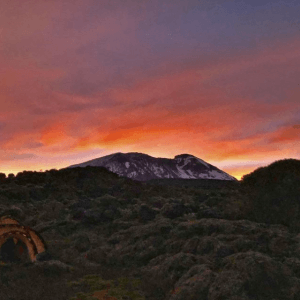
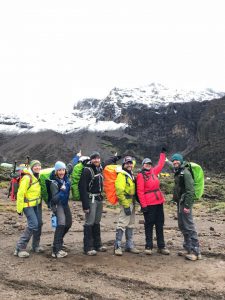
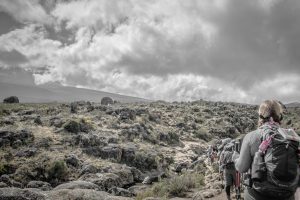
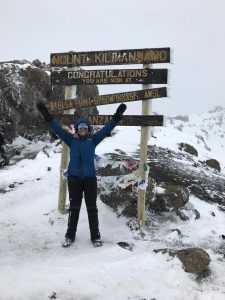
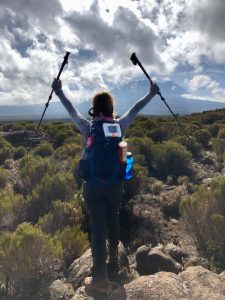
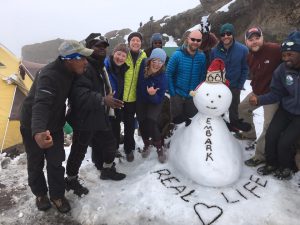
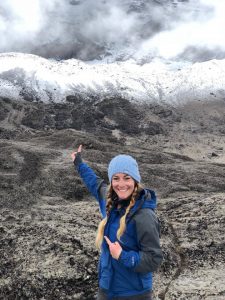
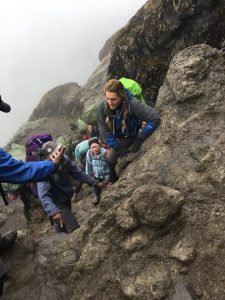
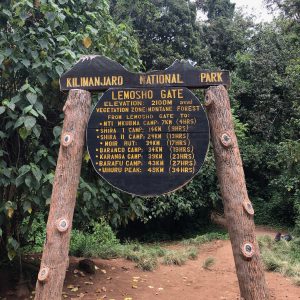
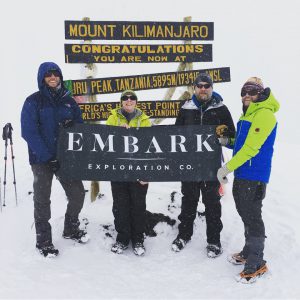

Leave a Reply